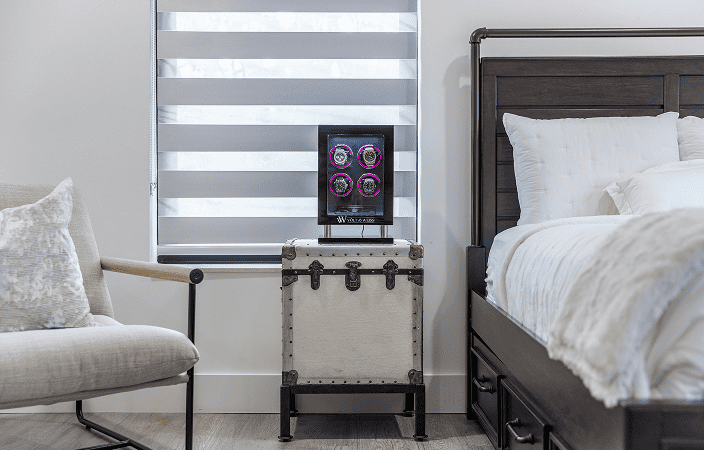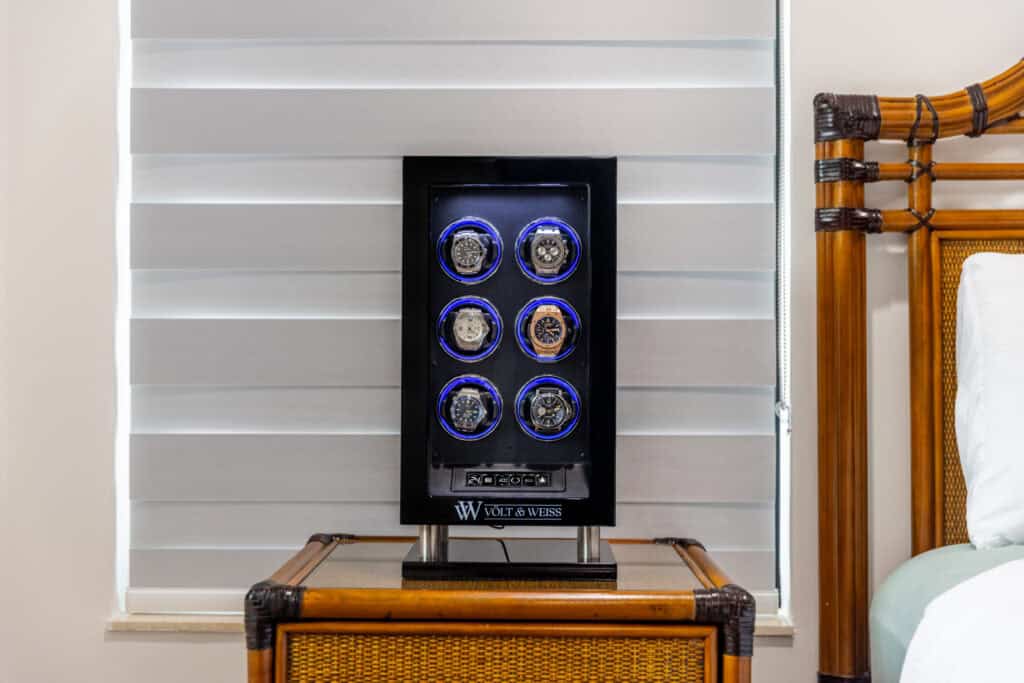Are all Rolex watches self winding? The story takes us back to 1931. Rolex revolutionized the watchmaking industry by inventing the first self-winding mechanism with a Perpetual Rotor. This revolutionary innovation made manual winding obsolete by using the wearer’s wrist movement to power the watch.
Modern Rolex watches are mostly automatic, but the company’s history reveals an interesting exception. The Oysterquartz, manufactured from 1977 to 2001, stands as the only Rolex model that used a battery. Rolex produced approximately 24,000 units during this period. Today’s Rolex watches come with power reserves ranging from 48 to 72 hours. These timepieces can run for up to three days without being worn.
This piece explores Rolex movements’ development, explains self-winding mechanisms, and shows you when your Rolex timepiece might need manual winding.
The Evolution of Rolex Watch Movements
The sort of thing I love is the story of Rolex’s movement technology. The story began in 1905 when Hans Wilsdorf started a company that specialized in timepiece distribution.
From Manual to Automatic: A Historical Experience
Wilsdorf showed his determination to create precise wristwatches in the early 1900s. He worked with Swiss watchmaking companies in Bienne to give his timepieces small, accurate movements. This partnership led to one of the most important milestones – Rolex became the first watch to receive an official chronometer certificate in 1910.
The Revolutionary Perpetual Rotor of 1931
A watershed moment in watchmaking history came in 1931. Rolex developed and patented the Perpetual rotor, a system that changed how watches operated fundamentally. The clever design had a half-moon-shaped component that rotates in both directions with Earth’s gravity.
Rolex brought in the remarkable red reversing wheels in 1959 that allowed winding whatever the rotation direction. The company also added a smart clutch system that prevents overwinding and protects the mainspring.
Modern Movement State-of-the-art
Over the last several years, Rolex’s movement technology has seen remarkable advances. Here are the state-of-the-art features:
- The Parachrom hairspring (2000): Five years of R&D created this component that’s ten times more resistant to shocks and immune to magnetic fields
- The Paraflex system (2005): A strong shock absorber that improves shock resistance by up to 50%
Rolex launched their new-generation movements in 2015 with improvements in all but one of their components. The Chronergy escapement stands at the heart of this advancement and provides:
- A 15% increase in efficiency
- An extended power reserve of approximately 70 hours
- Better resistance to magnetic interference
The Manufacture des Montres Rolex S.A. in Bienne now manufactures and assembles all these components. Each part goes through strict checking, control, and inspection because every detail matters in creating these exceptional timepieces.

Understanding How Rolex Self-Winding Works
Modern Rolex watches run on an ingenious mechanism that we need to understand first. This remarkable system employs energy from our daily movements and eliminates the need for batteries or constant manual winding.
The Science Behind the Perpetual Rotor
The brilliance of Rolex’s self-winding mechanism comes from its half-moon-shaped oscillating weight that pivots freely on its axle. Earth’s gravity makes this weight rotate silently with even the smallest wrist movement. The kinetic energy from these rotations flows through the winding mechanism’s wheels to the mainspring.
The system works smoothly whatever the rotation direction, thanks to the distinctive red reversing wheels introduced in 1959. A sophisticated clutch system prevents overwinding once the spring reaches maximum tension.
Power Reserve and Energy Storage
Modern Rolex watches show remarkable improvements in their power reserve capabilities. Different models display varying power reserves:
| Caliber | Power Reserve | Notable Feature |
|---|---|---|
| 3230 | 70 hours | Optimized ball bearing |
| 2232 | 55 hours | Syloxi hairspring |
The mainspring stores this energy with precision and provides consistent power to the movement even when you’re not wearing the watch. Rolex has become skilled at both storing and releasing energy to the movement’s components through continuous refinement.
Are All Rolex Watches Self Winding? Misconceptions
Some common misunderstandings about Rolex’s self-winding mechanism need clarification:
- Invention Credit: Many believe Rolex invented the automatic winding mechanism. John Harwood created the first wristwatch with an automatic winding mechanism in 1924.
- Rotor Innovation: Rolex stands out because it refined the system. The Perpetual rotor could spin a full 360 degrees, unlike Harwood’s 300-degree limitation.
- Winding Direction: Some people think the rotor works in one direction only. The mechanism captures energy from movement in any direction efficiently.
Different Types of Rolex Movements Through History
Rolex’s rich history shows remarkable changes in their movement technology. The brand we know today evolved through a fascinating progression from manual to automatic movements.
Manual Wind Models (Pre-1931)
Rolex produced watches with manual movements before self-winding mechanisms existed. The caliber 1200 series was their main manual-winding movement.
Production numbers stayed modest compared to modern standards. These simple movements created the foundation for future breakthroughs.
The Oysterquartz Era
Rolex began an unexpected venture into quartz technology in 1977. They introduced their in-house quartz movements – calibers 5035 and 5055 after five years of careful development. These movements stood out from ordinary quartz calibers with unique features:
- Geneva stripes decoration, typically reserved for premium mechanical movements
- Superior accuracy compared to mechanical counterparts
- COSC chronometer certification
The Oysterquartz production continued until the early 2000s. Only 25,000 units were manufactured, which makes these models a collector’s treasure today.
Contemporary Automatic Calibers
Rolex’s steadfast dedication to breakthroughs shines through its modern movement portfolio.
The company reached a major milestone in 2015 with the 3235 and 3255 calibers. The design team reimagined over 90% of movement parts. Here’s how different models use the current generation of movements:
| Caliber | Function | Models |
|---|---|---|
| 3235 | Time and date | Datejust, Submariner Date |
| 3255 | Day-date | Day-Date 36/40 |
| 3230 | Time only | Oyster Perpetual, Air-King |
| 3285 | GMT and date | Explorer II, GMT-Master II |
These new-generation movements feature 14 patents that deliver better precision, reliability, and power reserve. The Parachrom hairspring came in 2005. It resists magnetic fields and temperature variations remarkably well. This shows Rolex’s dedication to horological excellence.
When Manual Winding is Necessary
Rolex’s self-winding mechanism is sophisticated, but manual winding becomes necessary in several situations. Let’s look at these scenarios to help you keep your timepiece running at its best.
First-Time Watch Setup
Your new Rolex needs manual winding right from the start. The watch needs a minimum of 25 turns to achieve adequate partial winding. The automatic mechanism will maintain power as long as you keep wearing it on your wrist.
After Extended Non-Use
Your Rolex may stop running if it’s stored away or rarely worn. Modern Rolex watches can run between 48 and 72 hours on their power reserves. Here’s what you should know if your watch has completely stopped:
- A full wind needs about 30-40 clockwise turns
- The crown must be completely unscrewed for winding
- Most modern watches include safety features to prevent overwinding
Low Activity Wearing Patterns
Your watch’s power reserve depends heavily on wearing patterns. People who wear their Rolex only during weekdays might face these challenges:
| Wearing Pattern | Power Reserve Impact |
|---|---|
| Weekend Storage | May stop by Monday if the power reserve is under 48 hours |
| Occasional Use | Requires monthly winding to maintain lubrication |
| Regular Wear | No manual winding is typically needed |
People who switch between multiple watches can try these two practical approaches:
- Use an automatic watch winder to maintain the power reserve
- Give your watch a complete manual wind every couple of months to ensure proper oil distribution
Your Rolex’s internal components could get damaged if left sitting without running. You should wind your watch at least once monthly during storage periods to protect your investment.

Proper Care for Your Self-Winding Rolex
Your self-winding Rolex needs proper care to last longer and hold its value. These timepieces are much more than investments – they become cherished possessions that deserve the best care possible. Let’s look at some proven ways to keep your Rolex in perfect condition.
Daily Wearing Best Practices
Your Rolex performs best when you wear it regularly. Daily wear isn’t just convenient – it helps your timepiece stay healthy. The movement of your watch keeps lubricants flowing properly throughout the mechanism.
These proven cleaning practices will help:
- A microfiber cloth will preserve your watch’s luster
- Soapy water and a soft brush work best to clean the case and bracelet
- Fresh water should rinse the watch after saltwater exposure
Your watch’s winding crown must stay properly screwed down against the case to keep water out. This simple habit protects your investment from moisture and debris.
Storage Recommendations
Smart storage choices work hand in hand with proper wearing habits to preserve your Rolex. Watch collectors who switch between multiple timepieces should think over these storage options:
| Storage Duration | Recommended Solution |
|---|---|
| Overnight | Cushioned watch box |
| Occasional Wear | Watch winder |
| Long-term | Climate-controlled safe |
Watch winders become especially valuable with complex models that feature perpetual calendars or moon phases. Your timepiece needs protection from:
- Extreme temperature fluctuations
- High humidity levels
- Direct sunlight exposure
Professional Service Intervals
Modern Rolex watches now have longer service intervals thanks to recent innovations. Most models need a complete service about every 10 years. All the same, this timeline can change based on:
- Usage patterns
- Environmental exposure
- Model complexity
Professional servicing includes these steps:
- Complete movement disassembly
- Ultrasonic cleaning of components
- Replacement of worn parts
- Electronic testing for timing accuracy
- Waterproofness verification
The service usually takes 4-6 weeks. You should get annual water resistance checks if you swim or dive with your watch.
Vintage Rolex models and watches made before the 1960s might need more frequent service. These classic timepieces stay precise and valuable with shorter service intervals.
Conclusion
Rolex’s self-winding watches showcase remarkable horological engineering that spans almost a century since the groundbreaking Perpetual rotor of 1931. These timepieces combine historical excellence with state-of-the-art features. The revolutionary red reversing wheels, modern Parachrom hairspring, and Chronergy escapement demonstrate this perfectly.
Most modern Rolex watches come with automatic movements, but some situations require manual winding. Watch owners should know these scenarios to protect their investment and get optimal performance. A well-maintained Rolex depends on regular wear, proper storage, and scheduled maintenance.
Rolex’s latest generation of movements demonstrates the brand’s steadfast dedication to excellence with extended power reserves and better resistance to external forces. Modern Rolex watches deliver unprecedented reliability and precision. Your Rolex, whether it’s a classic Datejust or a professional Submariner, serves as both a practical timekeeper and evidence of watchmaking mastery.
FAQs
Q1. Are all modern Rolex watches self winding?
Yes, virtually all modern Rolex watches are self-winding (automatic). They use a Perpetual rotor mechanism that harnesses the natural movement of the wearer’s wrist to power the watch, eliminating the need for manual winding in most cases.
Q2. Did Rolex ever produce battery-powered watches?
Yes, Rolex did produce a battery-powered watch called the Oysterquartz from 1977 to 2001. However, this was an exception in Rolex’s history, with only about 24,000 units manufactured during this period.
Q3. How long can a Rolex watch run without being worn?
Modern Rolex watches typically have power reserves ranging from 48 to 72 hours. This means they can continue running for up to three days without being worn or manually wound.
Q4. When is manual winding necessary for a Rolex watch?
Manual winding is necessary when setting up a new Rolex for the first time, after extended periods of non-use, or if the watch has stopped due to infrequent wear. It’s also recommended to wind the watch manually at least once a month during long storage periods.
Q5. How often should a Rolex watch be serviced?
Rolex recommends a complete service approximately every 10 years. However, this interval may vary based on usage patterns, environmental exposure, and model complexity. Annual water resistance checks are advised for watches frequently used while swimming or diving.














